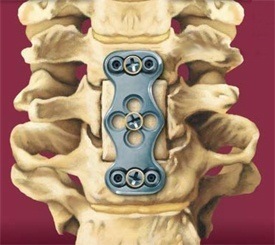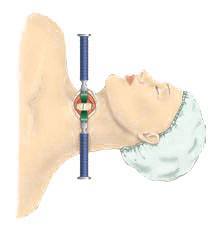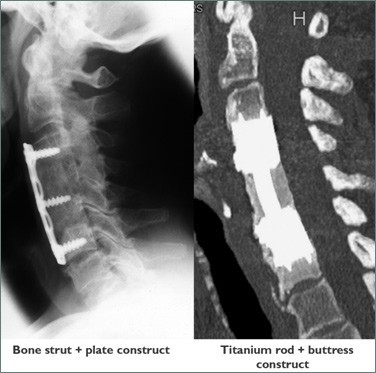
An anterior cervical corpectomy and fusion is a surgical procedure in which vertebral bone and intervertebral disc material is removed to relieve pressure on the spinal cord and spinal nerves in the cervical spine.
The term corpectomy is derived from the Latin words corpus (body) and -ectomy (removal). Removal of one or more vertebral bodies is sometimes necessary if the spinal cord and/or exiting spinal nerves are being compressed by disc and bone which cannot be removed merely by removing the disc(s). The procedure involves accessing the cervical spine through a frontal approach. Spinal fusion is usually necessary because of the amount of vertebral bone and/or disc material that must be removed to achieve sufficient decompression of the neural structures.
Spinal fusion involves placing bone graft or bone graft substitute between two or more affected vertebrae to promote bone growth between the vertebral bodies. The graft material acts as a load-bearing strut, and the vertebral bone and substance of the strut eventually grow together to stabilize the spine.
Why Might I Need This Procedure?
Nerve compression in the cervical spine can cause neck pain and/or pain, numbness and weakness that extends into the shoulders, arms and hands. Compression of the spinal cord is more serious, and may lead to sensory disturbance in arms, legs or trunk; weakness or paralysis in arms or legs; distrurbance in male sexual function; or loss of control of bowel and bladder.
Compression of cervical nerves and/or cervical spinal cord can occur due to arthritis, ageing changes in the spine, tumours or trauma.
Dr. Rosenberg will tell you if cervical corpectomy and fusion is the best operation for you, in the event that you are forced sooner or later to resort to surgery.
Dr. Rosenberg will always explain your non-surgical option (if there is one) as well as the surgical option along with its success rate, failure rate and risks. Except when cancer or dangerous spinal instability is present, it is always Dr. Rosenberg’s advice that if you are then not sure about having surgery, you should choose not to have surgery for the moment. Stop, think, and let some time pass, and the correct way for you to manage your condition will become clear.

How Is A Cervical Corpectomy Performed?
Through an incision on the front of your neck, Dr. Rosenberg will
- Gently retract the muscles and tissues of the neck to expose the anterior vertebral column
- Remove portions of one/more vertebral bodies and intervertebral discs to access the compressed neural structures
- Relieve the pressure by removing the source of the compression
- Place a strut of bone, PEEK plastic or titanium between the adjacent vertebrae at the decompression site
- In some cases (depending on the type of construct) Dr. Rosenberg will attach instrumentation such as plating and screws, to the front of the spine to provide extra support and stability while fusion and healing occurs

How Long Will It Take Me To Recover?
Dr. Rosenberg will advise you in detail on the post-operative recovery/exercise plan to help you return to your normal activity level as soon as possible. The amount of time that you have to stay in the hospital will depend on this treatment plan. You typically will be up and walking in the hospital by the end of the first or second day after the surgery. You may return to work in 3-6 weeks, depending on how well your body is healing and the type of work/activity level you plan to return to.
Every patient is different, however, and Dr. Rosenberg will determine the appropriate recovery protocol for you. Please note that much of this advice is for your safety, and thus it is important that you follow it to the letter.
Are There Any Potential Risks Or Complications?
Any surgery and anaesthesia can result in injury or even, rarely, death. One only has to read the newspaper to confirm that fact. Complications such as infection, nerve damage, blood clots, blood loss and bowel and bladder problems, along with complications associated with anaesthesia, are some of the potential risks of spinal surgery. A potential risk inherent to spinal fusion is failure of the vertebral bone and graft to properly fuse, a condition that may require additional surgery.
Dr. Rosenberg will tell you the types and magnitudes of risks for you undergoing a given procedure.
